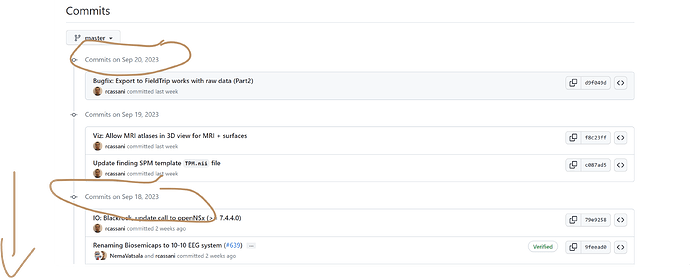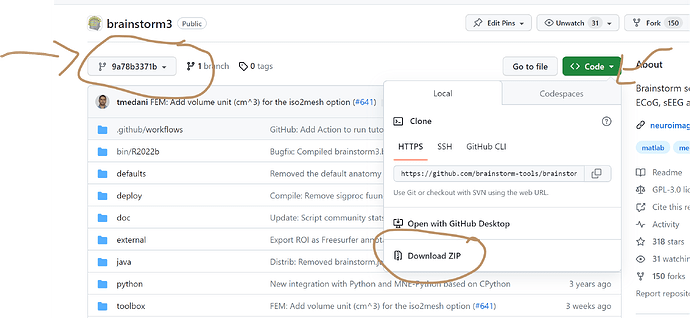Hello,
I would like to know if an older version of Brainstorm is available.
Let me explain: I am analyzing MEG data in Brainstorm, I would then export
the “.ds” file and run the DipoleFit with the CTF software (leaving out FieldTrip).
I know that the most recent versions of Brainstorm do not allow you to export files in “.ds” format
so I would like to know if it is possible to have an older version (probably of 2012?).
Thank you in advance!
Hello,
The export in CTF .ds format was never properly implemented in Brainstorm.
At some point, we had a hack letting users overwrite the existing values in the CTF .meg4 files with values filtered with Brainstorm. This was allowed only for frequency filters, which you can already run in the CTF software anyway.
I don’t recommend you use this now…
If you still want an old version of Brainstorm, I can send it to you, but I don’t think it will be of any help for you.
If you want to run the CTF DipoleFit program, I think you have to do all your preprocessing with the CTF software.
You can also ask the CTF support if they have any solution to offer (such as importing data from ASCII files).
Sorry for the discouraging response
Francois
Ok, thanks anyway!
Hello Francois & Brainstorm team,
Our team was processing EEG data using the pre-2019 imaginary coherence function, instead of 2023. We just tried running more participants' data and brainstorm output many errors.
In further investigation, we found that the pre-2019 version of imaginary coherence was removed from Brainstorm. We received the error at the bottom of this post. Further, we do not see the pre-2019 version in the options for running coherence.
It is not best practice to change the coherence function in the middle of a study, so we would like to avoid this if at all possible. Therefore, we are wondering if we could have the older version of Brainstorm that still contains the pre-2019 coherence function, or if another update could be pushed that adds the pre-2019 version back to Brainstorm. Would either of these options be possible?
We currently have the v. 3.230919 (19-Sep-2023) Brainstorm version installed.
Thank you for the consideration, we appreciate it.
Best,
Adam
- Error: Please check the advanced options of the process "Coherence AxB [2023]"
before running the pipeline.
** Error: Line 3016: Unrecognized function or variable 'sSelProcesses'.
**
** Call stack:
** >panel_process_select.m>ShowPanel at 3016
** >panel_process_select.m at 32
** >panel_process2.m>RunProcess at 142
** >panel_process2.m at 26
** >gui_brainstorm.m>CreateWindow/ProcessRun_Callback at 777
** >bst_call.m at 28
** >gui_brainstorm.m>@(h,ev)bst_call(@ProcessRun_Callback) at 298
Hi @bakerdon
Getting back to any version of Brainstorm from the GitHub repo is possible;
Here is the link for the version of July 2019: https://github.com/brainstorm-tools/brainstorm3/archive/a41de80e9bd966f15d5cfb016b81cbb072d71be4.zip
You can get any version by browsing the commits on the GitHub page and
1- click on commits:
2-look for the date of the version you want to get; you can scroll down and look for older version
3- When you find the version you want, you click on the "<>" => Browse the repo at this point in the history
4- On the new page, click on "Code" and then download the zip,
You will have the old version of the brainstorm at the selected time of the commit.
Hi Takfarinas,
Thank you for the quick reply! We appreciate it. We were successful in getting the older version.
This brings up a set of related questions: Why was the pre-2019 imaginary coherence function removed? Was there an error found in the pre-2019 version that was fixed in the 2023 version? Lastly, what are the differences between the two equations?
If there are no issues with the pre-2019 version, would it be possible to add it back to Brainstorm in future updates? We would like to continue using the pre-2019 version, assuming no issues are present, while not missing future Brainstorm updates.
Thank you for the assistance, as always. We appreciate all your help!
Best regards,
Adam
Hi Adam,
The error just indicates that it is necessary to click in the Edit button to verify the parameters for the time-frequency transformation that will be used.
The option is not accessible through the GUI, but can be used by older pipelines scripts.
Imaginary coherence in Brainstorm before 2019 was computed as:
IC = imag(C)^2 / (1-real(C)^2)
Later in 2019 imaginary and lagged coherence were updated to be computed using the common definition in the literature. Moreover, note that the old (pre-2019) definition of imaginary coherence is actually the square of the lagged coherence.
-
Nolte G, Bai O, Wheaton L, Mari Z, Vorbach S, Hallett M.
Identifying true brain interaction from EEG data using the imaginary part of coherency.
Clinical Neurophysiology. 2004 Oct;115(10):2292–307. -
Pascual-Marqui RD.
Coherence and phase synchronization: generalization to pairs of multivariate time series, and removal of zero-lag contributions.
arXiv preprint arXiv:0706.1776. 2007 Jun 12.
In addition to the formula used pre-2019 for imaginary coherence.
The computation of coherence (in all its flavors) was updated in 2021
First commit, coherence-2021 by rcassani · Pull Request #423 · brainstorm-tools/brainstorm3 · GitHub
Thus coherence computed before and after 2021 will be slightly different
Hi Raymundo,
Thank you for the detailed response. I really appreciate it.
If you don't mind, I have an additional question regarding the differences between coherence functions for surface EEG data: when is the use of lagged coherence more suited for EEG data than using imaginary coherence, or vice-versa?
Thank you again for the advice.
Best,
Adam
You can check the the references for those two metrics in:
https://neuroimage.usc.edu/brainstorm/Tutorials/Connectivity#Coherence
As well as this review con connectivity metrics:



